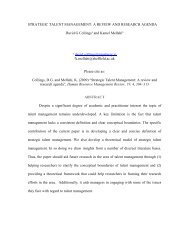Testo letterario e ipertesto - National University of Ireland, Galway
Testo letterario e ipertesto - National University of Ireland, Galway
Testo letterario e ipertesto - National University of Ireland, Galway
You also want an ePaper? Increase the reach of your titles
YUMPU automatically turns print PDFs into web optimized ePapers that Google loves.
della letteratura torna quindi ad essere centrale nell’educazione, anche in quella<br />
linguistica e (inter)culturale:<br />
In the Vygotskian perspective, ‘human social and mental activity is organised<br />
through culturally constructed artefacts’ (Lantolf, 2000: 1). This is an important<br />
idea because it potentially returns literature to a central role as texts through<br />
which language learners can explore who they are and who they are not, and<br />
who they might be becoming as they participate 25 in this new language.<br />
Language learning is seen as the development <strong>of</strong> new ideas and personality,<br />
rather than acquisition <strong>of</strong> a set <strong>of</strong> new labels for familiar object or at most <strong>of</strong><br />
new syntactic rules. Thinking and languaging are effectively inseparable in<br />
practice […]’ (ivi: 77).<br />
L’importanza dell’interazione con le situazioni presentate nei testi e il<br />
coinvolgimento della personalità del discente vengono sottolineati anche da Kramsch<br />
principalmente in due occasioni: quando si riferisce alla potenziale dicotomia<br />
‘conscious application <strong>of</strong> rules’ vs ‘uncosciuous acquisition <strong>of</strong> conversational patterns’<br />
(1993: 5) e richiama la visione di Halliday sul linguaggio considerato come ‘social<br />
semiotic’ 26 ; e ancora quando definisce la nozione di contesto come ‘relational’ (ivi: 67)<br />
indicando quanto la persona che si trova in una determinato contesto riesca a dargli una<br />
forma, a modellarlo a seconda dei livelli su cui si sviluppa l’interazione:<br />
In each <strong>of</strong> its five dimensions: linguistic, situational, interactional, as well as<br />
cultural and intertextual, it [the context] is shaped by people in dialogue with<br />
one another in a variety <strong>of</strong> roles and statuses. Because the language is at the<br />
intersection <strong>of</strong> the individual and the social, <strong>of</strong> text and discourse, it both<br />
reflects and construes the social reality called ‘context’ (ibid.).<br />
Kramsch sottolinea quanto ‘the success <strong>of</strong> any communicative activity is<br />
heavily determined by the way the participants perceive the context <strong>of</strong> situation and<br />
shape it accordingly through their verbal and non-verbal behaviour’ (ivi.: 49). Il<br />
contesto, soprattutto in una prospettiva (inter)culturale, ricopre un’importanza<br />
fondamentale nell’insegnamento di una L2, poiché rappresenta la dimensione, a forte<br />
carattere culturale, in cui la competenza grammaticale e quella comunicativa non sono<br />
25 Sfard in un articolo del 1998 discute dei concetti di acquisition e participation definendole metafore e<br />
esaminandole da una prospettiva dell’apprendimento: ‘The act <strong>of</strong> acquisition is <strong>of</strong>ten tantamount to the<br />
act <strong>of</strong> becoming participant, and if so one can find it difficult to consider AM [acquisition metaphor] and<br />
PM [participation metaphor] separately, let alone as mutually exclusive (Sfard, 1998: 6).<br />
26 ‘Rather than an either – or dichotomy, grammar and communication can be seen within a view <strong>of</strong><br />
language as social semiotic (Halliday 1978, 1989, 1990). The structures which speakers choose to use<br />
and hearers choose to listen and respond to construct the very context <strong>of</strong> communication in which<br />
learning takes place. Rather than a dichotomy, then, we have multiple options regarding the way<br />
language is used in variable contexts <strong>of</strong> use’ (Kramsch, 1993: 5).<br />
25





